Categories > Guides and Tips
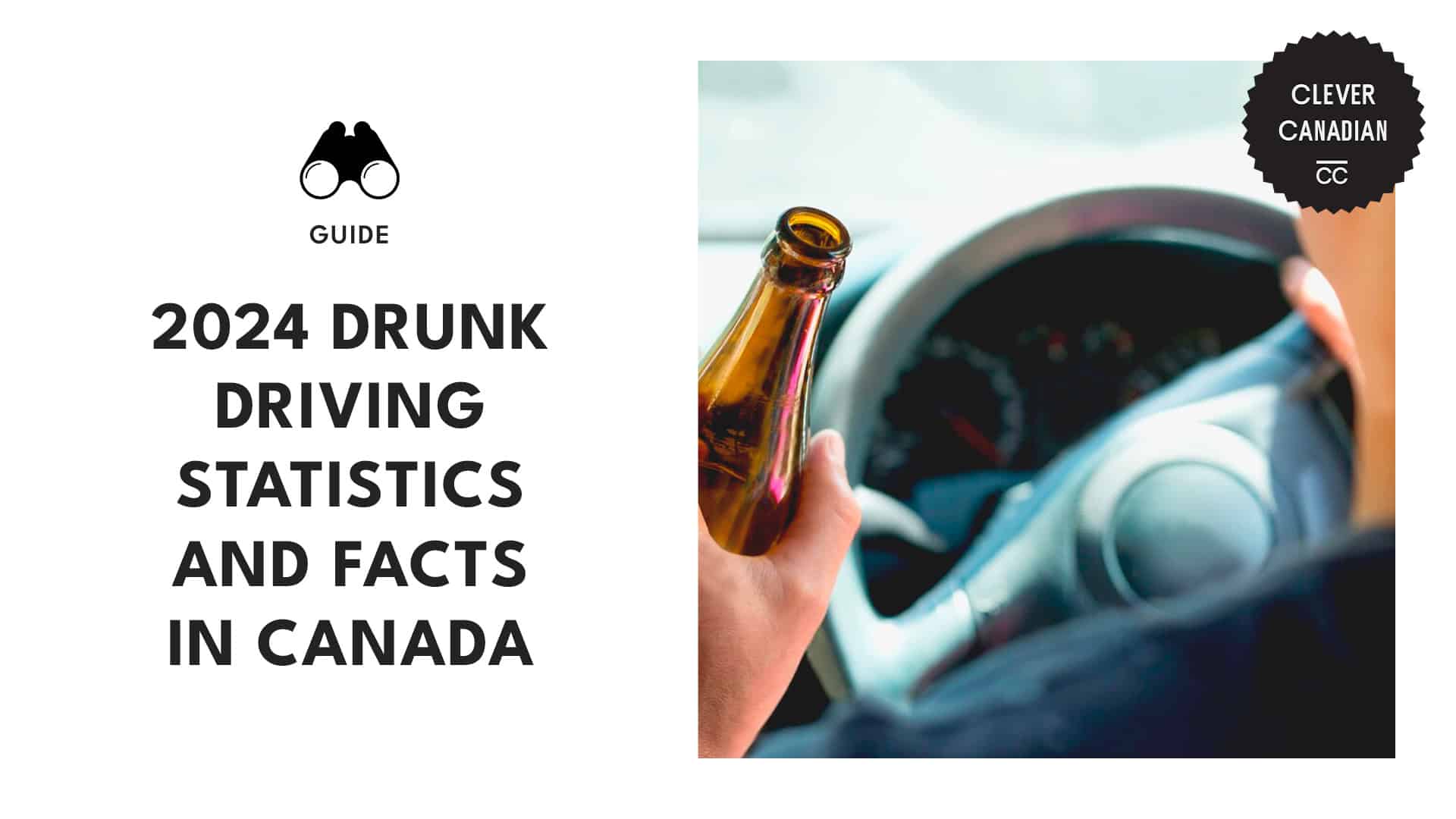
2024 Drunk Driving Statistics in Canada: A Public Safety Challenge
- Key Insights
- Total Reported Drunk Driving Incidents by Province in Canada
- Alcohol-Impaired Driving Charges per 100,000 Residents by Province
- Key Cities and Alcohol-Impaired Driving Trends
- The Scope of Drunk Driving in Canada
- Demographics and Patterns in Drunk Driving Behavior in Canada
- Drunk Driving by Gender in Canada
- Drunk Driving by Age Group in Canada
- Drunk Driving by Day and Time of Day in Canada
- The Cost and Consequences of Impaired Driving
- Canada’s Legal Framework for Combating Drunk Driving
- Canada’s Interventions and Future for Combating Drunk Driving
- References
Key Insights
- In 2022, Statistics Canada reported 57,221 alcohol-impaired driving incidents, continuing a downward trend from 69,253 in 2015.
- According to Statistics Canada, British Columbia recorded the highest number of alcohol-impaired driving cases in 2019 with 15,064 incidents. This is followed by Quebec (12,778) and Alberta (12,665).
- Saskatchewan had the highest rate of alcohol-impaired driving charges in 2021 (345 per 100,000), while Quebec had the lowest (93 per 100,000), based on Statista 2021.
- Statistics Canada reported that Moncton led Canadian cities with the highest rate of impaired driving in 2019, at 529 incidents per 100,000 population.
- Toronto saw a 52% decline in alcohol-related collisions from 149 in 2021 to 71 in 2022, highlighting the impact of local interventions like Mandatory Alcohol Screening (MAS) (Toronto Police Services Board, 2022).
Drunk driving has been a concern in Canada for several years.
According to Public Safety Canada, police reported 53,092 alcohol-impaired driving incidents, accounting for 74% of all impaired driving cases. The rate remained stable from 2021 to 2022 at 136 incidents per 100,000 population.
This stability comes after a sharp decrease in incidents following a peak of 72,983 in 2019, based on the 2024 CCSA report. It reflects a positive shift in efforts to curb impaired driving.
To provide a clearer picture of these trends, the following chart illustrates the number of alcohol-impaired driving incidents reported to police from 2015 through 2022.
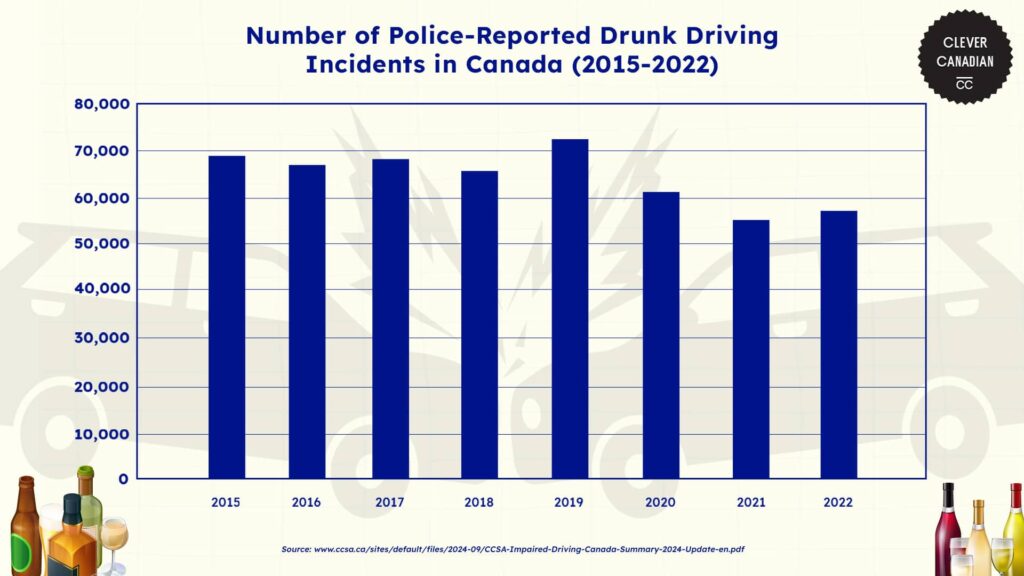
Statistics Canada reveals a downward trend in alcohol-impaired driving incidents in Canada over the years. The figure decreased from 69,253 in 2015 to 57,221 in 2022.
The most significant fall in this period was after 2019. The downward trend continued until 2022 when it slightly increased to 57,221 (up from 55,914 in 2021).
In all, reported incidents dropped by over 12,000 between 2015 and 2022, suggesting significant progress in addressing alcohol-impaired driving.
Total Reported Drunk Driving Incidents by Province in Canada
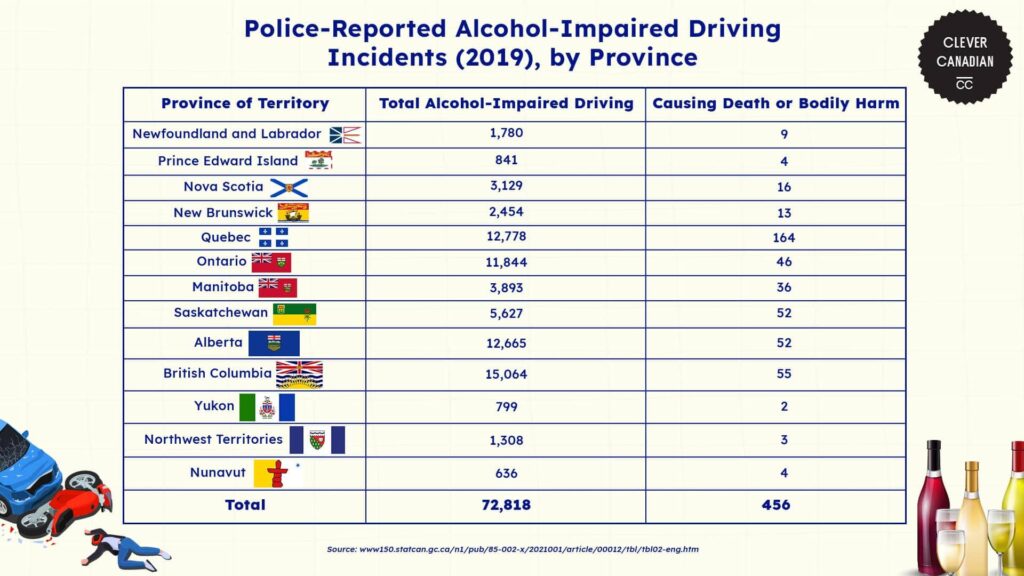
A look at 2019 figures gives an idea of how incidents are typically spread throughout the country.
Statistics Canada highlights that British Columbia recorded the highest number of impaired driving incidents in 2019 (15,064 cases). It accounts for nearly 21% of that year’s national total. Quebec and Alberta followed closely.
On the other hand, the lowest numbers were observed in Nunavut (636 cases) and Yukon (799 cases), likely due to their smaller populations and geographic isolation.
Notably, Quebec reported the highest number of incidents causing death or bodily harm with 164 cases. This makes up 36% of all such incidents nationwide.
Some smaller provinces, such as Prince Edward Island (841 cases) and Nova Scotia (3,129 cases), show notable incident counts despite their lower populations.
Meanwhile, the Atlantic provinces collectively report fewer incidents overall but still account for 42 cases with death or bodily harm. This suggests proportional impact across the region.
Alcohol-Impaired Driving Charges per 100,000 Residents by Province
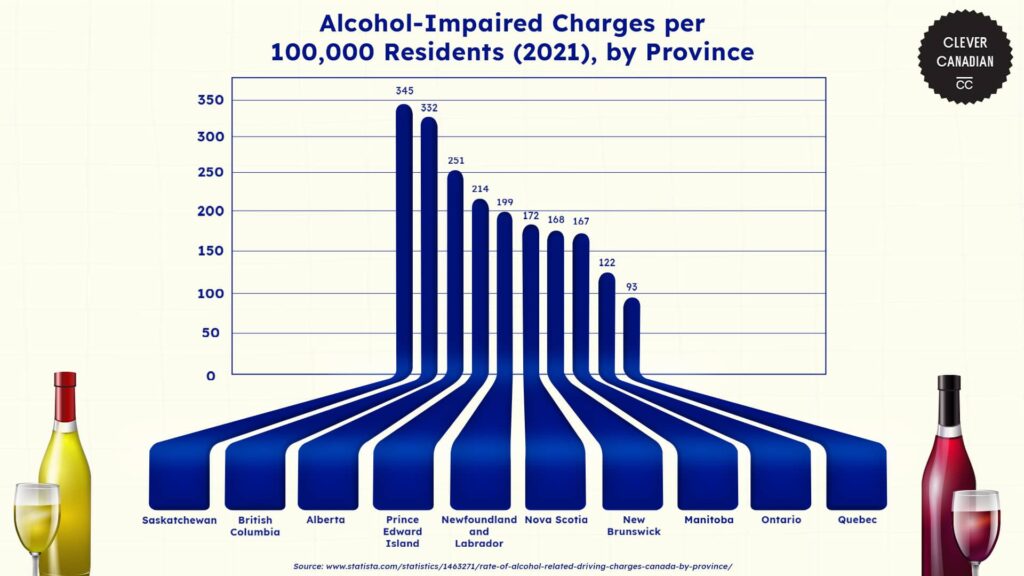
In 2021, Statista reported that Saskatchewan and British Columbia recorded the highest rates of alcohol-related driving charges in Canada per 100,000 residents (345 and 332 incidents per 100k, respectively).
Quebec had the lowest rate, with only 93 incidents per 100,000 residents.
These differences suggest the impact of factors like enforcement practices, public awareness efforts, and cultural attitudes toward impaired driving across provinces.
Key Cities and Alcohol-Impaired Driving Trends
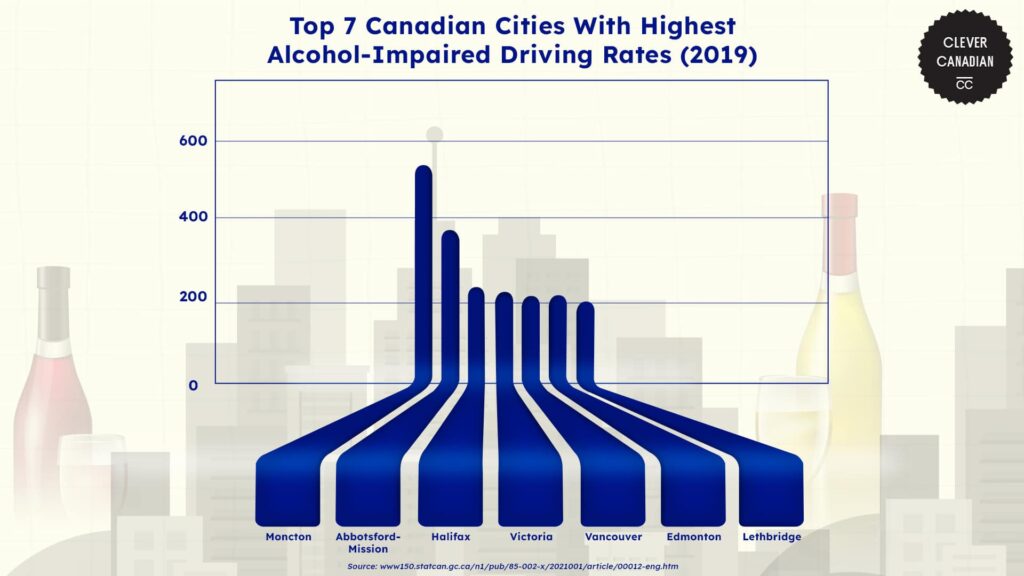
Based on the data from Statistics Canada, Moncton had the highest alcohol-impaired driving rate in 2019, with 529 incidents per 100,000 people.
Abbotsford-Mission followed, ranking second with 364 incidents per 100,000 people—approximately 31% lower than Moncton.
By comparison, the lowest-ranked areas include Halifax, Victoria, and Vancouver. Each reporting rate is below 250 incidents per 100,000 people, underscoring regional disparities in impaired driving rates.
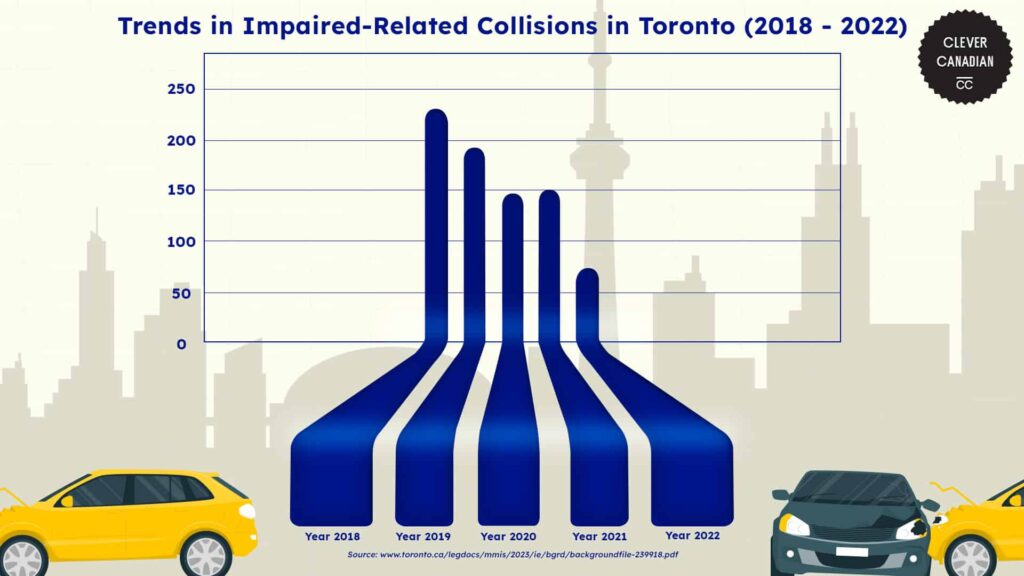
The most populous city in Canada, Toronto also faces significant challenges with raw numbers for impaired driving. It had 788 collisions attributed to drug or alcohol impairment between 2018 and 2022 alone.
According to the Toronto Police Services Board, there were 71 impaired-related collisions in the city in 2022. This is a 52% decrease from 149 incidents in 2021.
The same year, the Toronto Police Service (TPS) conducted 4,829 Mandatory Alcohol Screening (MAS) tests. It resulted in 4,718 passes, 92 warnings, and 19 fails.
Despite that, TPS also claims to have charged over 6,000 drivers with impaired driving offenses over the past five years.
The Scope of Drunk Driving in Canada
The Criminal Code of Canada prohibits driving with a blood alcohol concentration (BAC) of 0.08 or higher. Offenders face serious consequences, including fines of at least $1,000, license suspensions, and jail time of up to 10 years.
Despite that, the issue persists. Between January 1 and June 30, 2024, the Ontario Provincial Police (OPP) recorded 3,339 impaired driving charges.
This marked an increase from the 3,247 charges recorded during the same period in 2023.
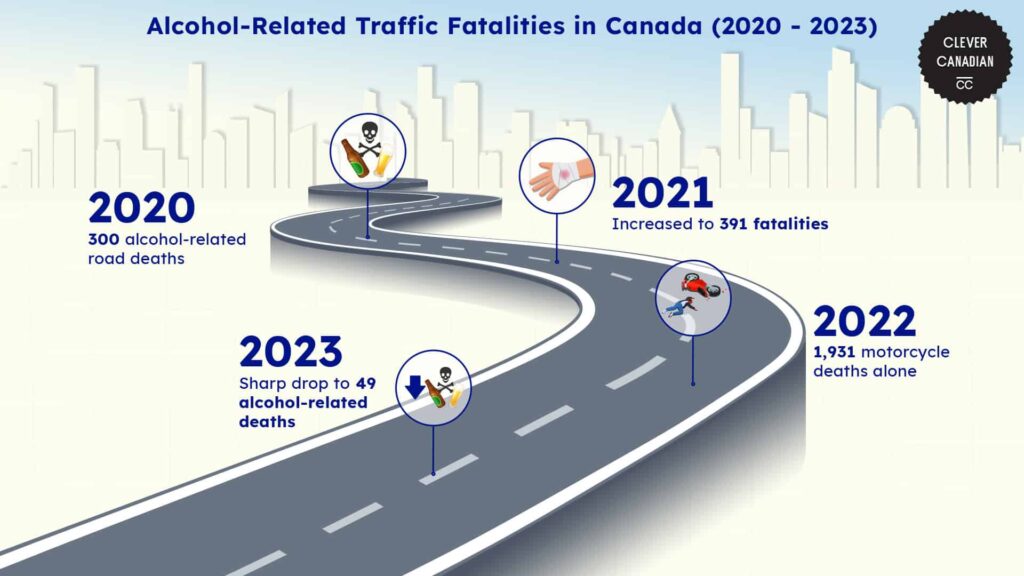
Fortunately, reports suggest that alcohol-related fatalities are decreasing. In 2020, there were 300 alcohol-related road deaths.
By 2023, a National Post report revealed that only 49 out of 397 total car crash fatalities involved alcohol impairment. This marks a significant drop in alcohol-related fatalities from 2020 to 2023.
Demographics and Patterns in Drunk Driving Behavior in Canada
Alcohol-impaired driving in Canada varies widely across demographics like age, gender, and time periods.
Drunk Driving by Gender in Canada
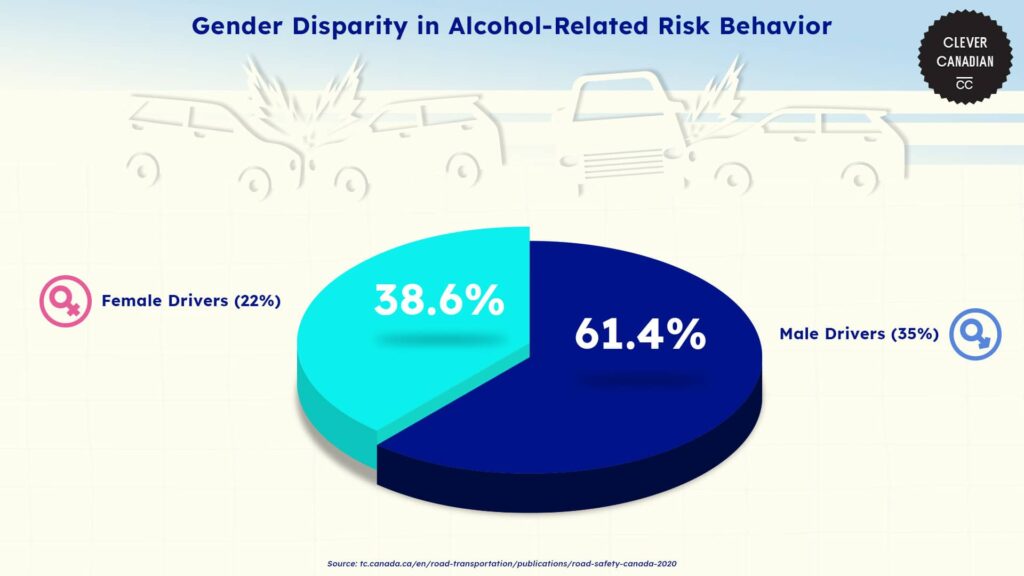
In 2019, males accounted for 77% of drivers accused of impaired driving. Females represented only 23% of accused drivers in 2019, though this still reflects an increase (from 8% in 1986 to 20% in 2015).
Building on this, Transport Canada’s 2020 report highlights gender disparities in fatal crashes: 35% of male drivers had been drinking compared to 22% of female drivers. 27% of males exceeded the legal blood alcohol limit, compared to 19% of females.
Drunk Driving by Age Group in Canada
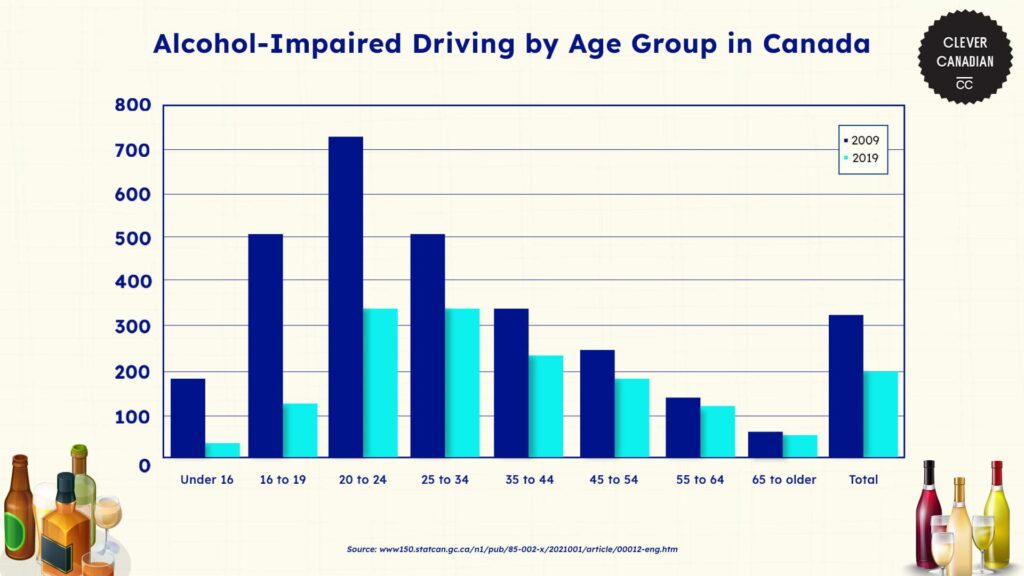
In a 2009 report from Statistics Canada, individuals aged 20 to 24 had the highest rate of drunk driving accusations at over 700 per 100,000 licensed drivers. This was followed by the 25 to 34-year-old age group.
By 2019, all age groups saw reductions. Yet the 20 to 24 age group still had the highest rate at around 400 per 100,000.
Overall, alcohol-impaired driving accusations dropped significantly in the decade between 2009 and 2019 across all age groups. It appears that most people charged with the offense are still at the ages of 20 to 24 and 25 to 34.
The 25 to 34 group is also typically one of the three biggest age groups among Canada’s licensed drivers.
Drunk Driving by Day and Time of Day in Canada
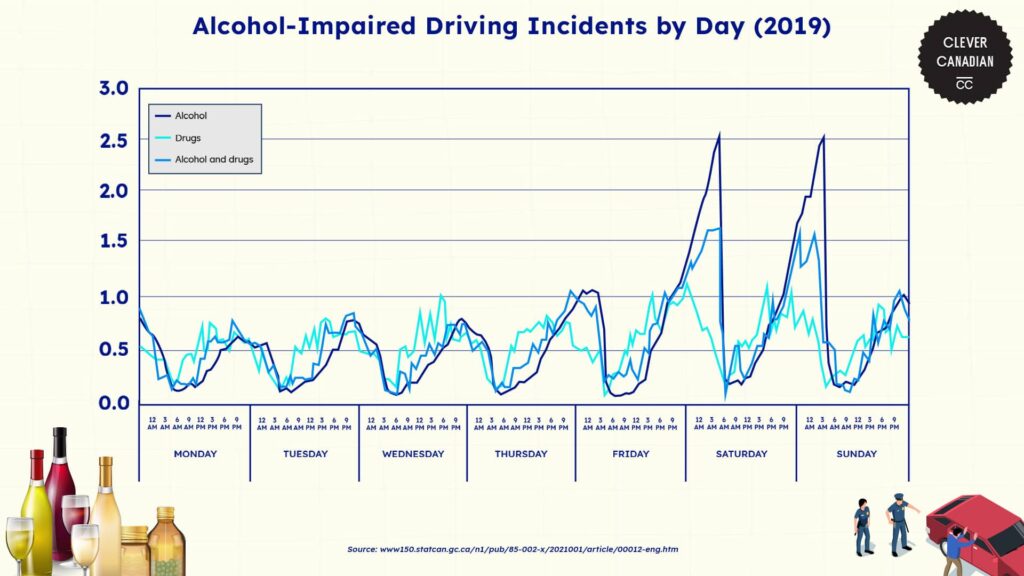
According to Statistics Canada, Alcohol-impaired incidents peak on Friday and Saturday nights, with the highest rate being around 2.5% (around midnight).
The late-night hours, particularly between 9 PM and 3 AM, show the most significant increase in alcohol-related incidents during weekends.
In contrast, alcohol-impaired incidents during weekdays (Monday to Thursday) remain consistently low. They average between 0.2% and 0.5% throughout the day. Evening hours (6 PM to 12 AM) see a slight increase, but rates stay below weekend peaks.
The lowest rates of alcohol-impaired driving occur during early morning hours on weekdays. Between 6 AM and 12 PM, incidents typically drop below 0.3%.
The Cost and Consequences of Impaired Driving
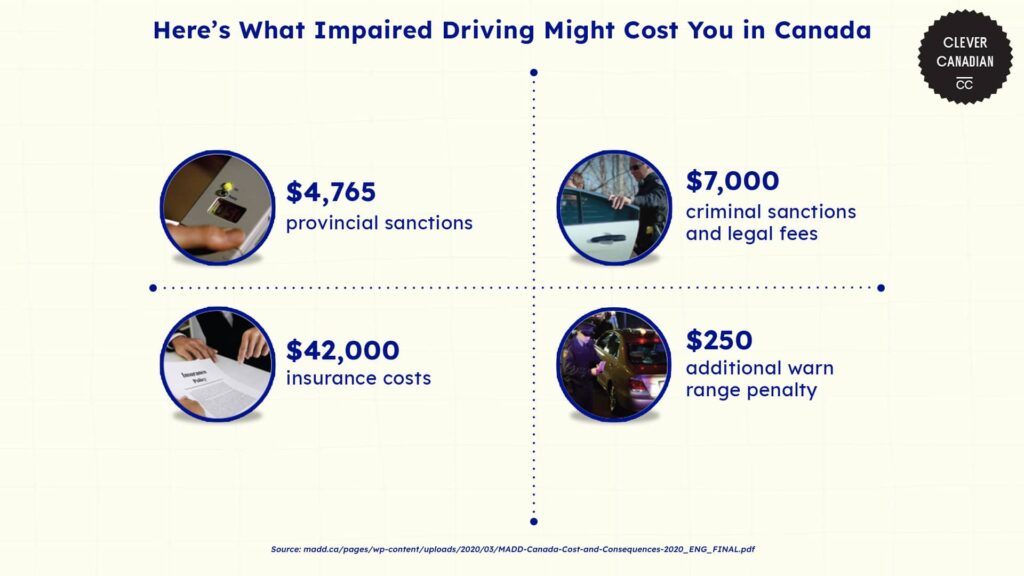
Costs and consequences vary by case and province. In Manitoba, the provincial sanction for drunk driving totals $4,765. It covers expenses like vehicle impoundment fees, administrative penalties, and enrollment in a mandatory remedial program.
Typically, offenders face criminal sanctions and legal fees that amount to around $7,000 on average. These fees reflect the costs of fines, court appearances, and legal representation.
The financial impact escalates significantly due to insurance costs over the next several years. Offenders classified as high-risk drivers may see their premiums increase by as much as $42,000.
As highlighted by MADD Canada, these driver costs can exceed $54,000, reflecting the substantial financial burden of impaired driving. This excludes indirect costs like lost income or additional penalties for repeat offenses.
Canada’s Legal Framework for Combating Drunk Driving
In 2018, mandatory alcohol screening was introduced to strengthen impaired driving laws. This allowed police forces to request breath samples from any lawfully stopped driver without suspicion.
As part of this approach, Canada’s penalties for impaired driving offenses are also now structured to escalate based on the severity and frequency of the violation:
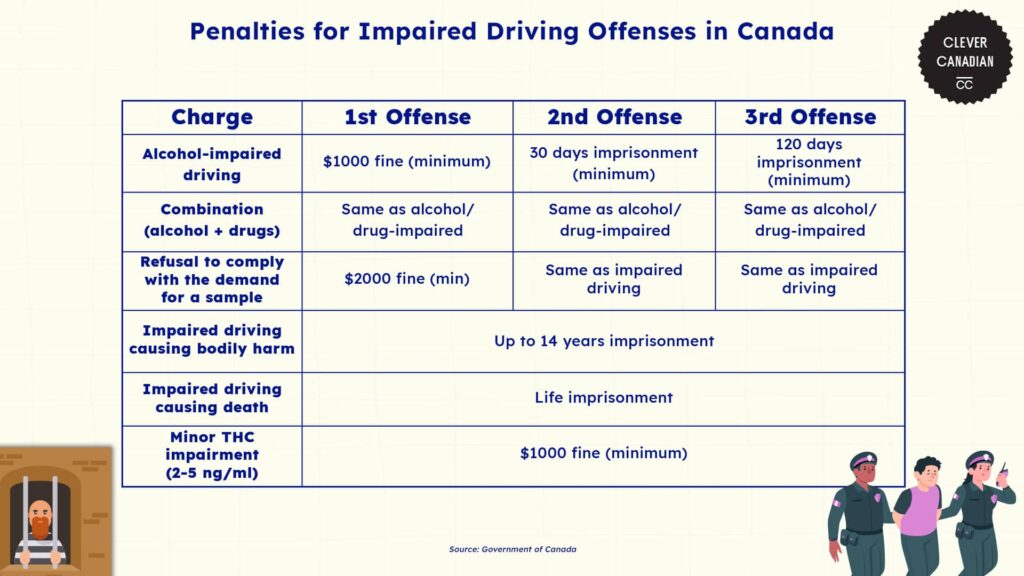
For first-time offenders of alcohol-impaired driving, penalties start with a minimum $1,000 fine, escalating to mandatory jail time for repeat offenses.
Refusing to provide a breath sample results in an even higher $2,000 minimum fine for first-time offenders. Subsequent refusals can subject individuals to penalties equivalent to impaired driving.
In cases causing bodily harm or death, the consequences are far more severe. Offenders face up to 14 years imprisonment for incidents causing bodily harm and life imprisonment for those resulting in fatalities.
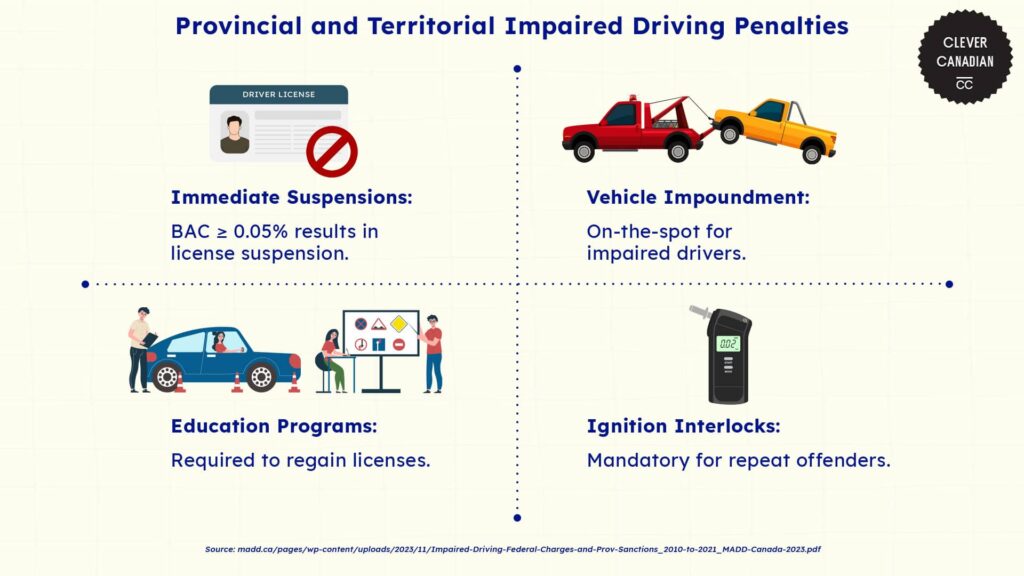
By May 2024, provinces and territories were also building upon federal impaired driving laws through immediate administrative measures. This includes vehicle impoundments, roadside license suspensions, and mandatory education or rehabilitation programs.
By combining federal laws with provincial measures, Canada is currently taking a multi-layered approach to reducing impaired driving incidents nationwide.
Canada’s Interventions and Future for Combating Drunk Driving
Even on a global scale, drunk driving remains a significant issue. In 2021, the World Health Organization reported that alcohol impairment contributed to about 25% of the 1.19 million road traffic deaths globally.
Canada faces a similar challenge, with MADD Canada reporting nearly 87,000 impaired driving charges and sanctions in 2019 alone.
Countries like the US may offer some ideas. Canada’s neighbor has taken a bold step to tackle impaired driving in a slew of new ways. This includes mandating impaired driving prevention systems in all new vehicles by 2026.
This move sets a significant precedent for other countries, including Canada. We have yet to implement similar nationwide legislation.
Canada is still making strides, particularly by adapting technologies like ignition interlock devices and alcohol detection systems. These innovations effectively reduce impaired driving, prevent repeat offenses, and save lives.
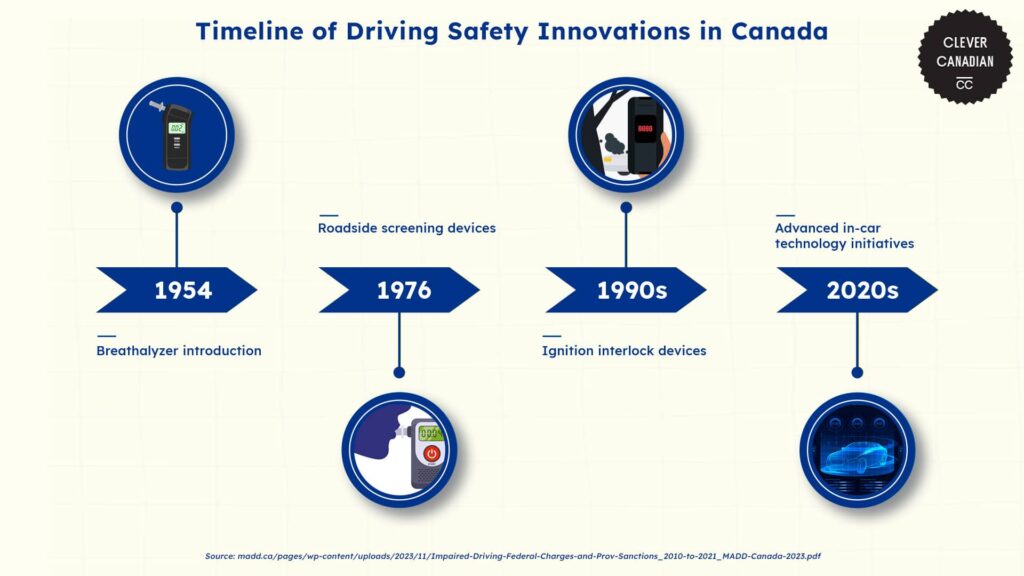
References
- Canadian Association of Chiefs of Police (2023). Operation Impact – National facts and stats. https://www.cacp.ca/_Library/Documents/202309251354441722619084_operationimpact2023nationalfactsstats.pdf
- Canadian Centre on Substance Use and Addiction (2024). Impaired driving in Canada. https://www.cacp.ca/_Library/Documents/202309251354441722619084_operationimpact2023nationalfactsstats.pdf
- Government of Canada (2023). Canadian Alcohol and Drugs Survey (CADS): 2019 detailed tables. https://www.canada.ca/en/health-canada/services/canadian-alcohol-drugs-survey/2019-summary/detailed-tables.html
- Government of Canada (2024). Canadian motor vehicle traffic collision statistics: 2022 https://wwwapps2.tc.gc.ca/Saf-Sec-Sur/7/NCDB-BNDC/p.aspx?l=en
- Government of Canada (2022). Impaired driving laws. https://www.justice.gc.ca/eng/cj-jp/sidl-rlcfa/#:~:text=The%20Criminal%20Code%20prohibits%20driving%20while%20impaired%20to,imprisonment%2C%20depending%20on%20the%20severity%20of%20the%20offence
- Mothers Against Drunk Driving. (n.d). Provincial short-term alcohol and drug-related suspensions & federal impaired driving charges 2010-2021.https://madd.ca/pages/wp-content/uploads/2023/11/Impaired-Driving-Federal-Charges-and-Prov-Sanctions_2010-to-2021_MADD-Canada-2023.pdf
- Mothers Against Drunk Driving. (2020). The cost and consequences of impaired driving. https://madd.ca/pages/wp-content/uploads/2020/03/MADD-Canada-Cost-and-Consequences-2020_ENG_FINAL.pdf
- Perreault, S. (2021). Impaired driving in Canada, 2019. Statistics Canada. https://www150.statcan.gc.ca/n1/pub/85-002-x/2021001/article/00012-eng.htm
- Public Safety Canada (2023). 2023 Annual national data report to inform trends and patterns in drug-impaired driving. https://www.publicsafety.gc.ca/cnt/rsrcs/pblctns/2023-did-fad/index-en.aspx
- Raveendran, R. (2024). Drunk driving is trending up in Ontario. CBC News. https://www.cbc.ca/news/canada/toronto/ontario-drunk-driving-1.7276492
- Statistics Canada (2019). Heavy drinking, 2018. https://www150.statcan.gc.ca/n1/pub/82-625-x/2019001/article/00007-eng.htm
- Statistics Canada (2023). Police-reported crime statistics in Canada, 2022. The Daily. https://www150.statcan.gc.ca/n1/dailyquotidien/230727/dq230727b-eng.htm
- Vankar, P. (2024). Number of Canadian deaths in road crashes due to drunk driving 1996-2021. https://www.statista.com/statistics/1466406/number-of-road-fatalities-due-to-drunk-driving-canada/






